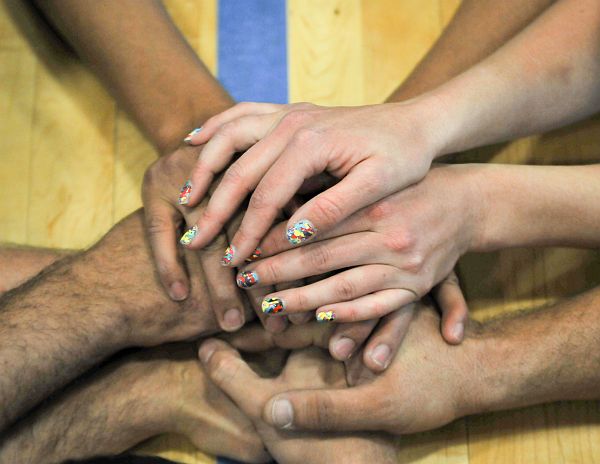This article was posted by CrystalWind.ca.
Why You Can No Longer Ignore The Most Potent Way To Transform Your Health
- Details

In a new perspective published by the New England Journal of Medicine, Penn Medicine behavioral economists suggest leveraging existing relationships with friends and family may be a more effective way to improve patients' health and encourage new healthy habits and behaviors than increasing interactions with physicians or other clinicians.
Who is more likely to be around when patients are deciding what to eat or whether to watch TV or take a walk -- a doctor or a spouse? A nurse-navigator or a friend? Convention has organized the process of health care into interactions between a clinician and a patient. But even patients with chronic illness may spend only a few hours a year with a physician, as compared with the thousands of waking hours when so much of what determines their health occurs out of clinicians' reach.
We've put so much emphasis on things versus people, we have forgotten how to connect to others to improve our health.
There is a five-step ladder to effectively engineering social engagements that promote health and to test their acceptability and effectiveness.
"Spouses and friends are more likely to be around patients when they are making decisions that affect their health -- like taking a walk versus watching TV, or what to order at a restaurant. Patients are also more likely to adopt healthy behaviors -- like going to the gym -- when they can go with a friend," explains co-author David Asch, MD, MBA, a professor of Medicine at the Perelman School of Medicine at the University of Pennsylvania and director of the Penn Medicine Center for Health Care Innovation who published Engineering Social Incentives for Health.
"Though people are more heavily influenced by those around them every day than they are by doctors and nurses they interact with only occasionally, these cost-free interactions remain largely untapped when engineering social incentives for health. That's a missed opportunity."
Existing social relationships have the additional advantage of being highly influential. You might be more likely to go to a gym if your friend also goes -- and even more likely if you go together. A couple who lost a combined 500 lb (227 kg) needed to find new friends to dine with because socializing with their old friends revolved around unhealthy eating. People are strongly influenced by what others do and by what others think of them, which means that our behavior can change or affect others' behavior when it's made visible. The notion that health-related behavior deserves extra privacy may explain why social-engagement strategies are uncommon. But because of the high cost and potential lost opportunities involved in keeping organized health care between clinicians and patients, we believe it's important to engineer social engagements that promote health and to test their acceptability and effectiveness.
Because of these lost opportunities, and the high costs when doctors and nurses keep tabs on their patients, the authors say it's important to engineer social engagements that enlist the social support patients already have, and allow organizations to test their acceptability. "Concerns about privacy are often the reason doctors and hospitals avoid organizing social support," Asch says. "But while privacy is very important to some patients under some circumstances, more often patients would love if their friends and family helped them manage their diabetes, and those friends and family want to help people get their health under control."
We are not meant to be alone - we are meant to be parts of bigger families, bands, and tribes. Human beings want and need the intimate support of a real family. Unfortunately, the nuclear family of our modern society is contracted. It is hard not to look at the "extended families" of some cultures with wistful longing, if not outright envy. Where I live, in southern Arizona, the Hispanic population seems way ahead of the rest of us in providing for the needs of family. In many Hispanic families the old people, even when infirm, continue to be valued members and live at home. Don't settle for nuclear family contraction. Extend!
The authors define a ladder with escalating rungs of social support ranging from no social engagement -- such as when a patient is expected to take medication as part of a routine, without anyone seeing them do it or holding them accountable -- to a design that relies on reputational or economic incentives, and incorporates teams or other designs that hold patients accountable for their health behaviors and habits.
"Although we don't normally think of competition or collaboration among patients are part of managing chronic diseases like high blood pressure, heart failure, or diabetes, research shows that behavior is contagious, and programs that take advantage of these naturally occurring relationships can be very effective," said co-author Roy Rosin, MBA, chief innovation officer at Penn Medicine. "Most health care interventions are designed for the individual patient, but there's a growing body of research that shows how health care organizations can use social engagement strategy to enhance health for patients who want to be involved in group activities or team competitions aimed at improving health."
For example, in the fourth rung, where social incentives are designed with reciprocal support, the authors point to a study in which some patients with diabetes were asked to talk on the phone weekly with peers -- a technique known as reciprocal mentorship -- and others received more typical nurse-led management. Results showed that those who worked directly with peers saw a more significant decline in glycated hemoglobin levels than those who worked with clinical staff.
"Sure, health care is serious business," Asch says, "but who says it can't be social?"
This model reveals opportunities to advance health by taking advantage of naturally occurring social forces. We don't normally think of competition or collaboration among patients as part of managing chronic diseases such as hypertension, heart failure, or diabetes, but why not? After all, teams of physicians often compete, sometimes explicitly, to improve performance ratings. Social interactions and competitions can also harness elements of surprise and fun. Yet health care organizations rarely consider the power of social ties to help patients and hardly ever think about fun ways to engage them.
Source: preventdisease.com
© CrystalWind.ca 2024. All content (articles, imagery, fair use) & design protected. Written permission required for copying. All rights reserved.
Join the Conversation Now! Comment Below! ![]()
Disclaimer Health
All post and information provided within this blog is for educational and informational purposes only, and is not to be construed as medical advice or instruction. No action should be taken solely on the contents of this website. Please consult with your healthcare professional before making any dietary or lifestyle changes or taking supplements that may interfere with medications. Any products or information discussed are not intended to diagnose, prevent, treat or cure any illness, disease or lifestyle. Please consult your physician or a qualified health professional on any matters regarding your health and wellbeing or on any opinions expressed within this website.

Spirit Animal Totem Of The Day!
Crystal Of The Day!
Latest Articles
The Crystal Wind Oracle
Myth & Magic Card Deck!
Details Here!
NEW Expanded
Printed & Boxed!
Now with 58 cards!
CrystalWind.ca is free to use because of
donations from people like you.
Donate Now »

Unlock Your Light: Join Lightworkers Worldwide on CrystalWind.ca!
Follow Us!
Who is Online Now
We have 36599 guests and no members online
Featured This Month
Cartomancy - Fortune Telling Using Playing C…
Cartomancy is the act of divining using cards. Divining means to find out by... Read more
The Crystal Wind Oracle Card Deck
The Crystal Wind Oracle™ The Crystal Wind Oracle Myth & Magic Card D... Read more
The Time of No Time: Beltane!
Around the medicine wheel of life we go, from season to season (solstice to ... Read more
Bright Beltane Blessings!
The wheel turns to Beltane, also known as Mayday, marking the beginning of S... Read more
Taurus Mythology
The Taurus Myth The Taurus myth is most often interpreted as the story of Z... Read more
Sun in Taurus
Sun in Taurus April 21 through May 21 An Overview of Sun Sign Characteristi... Read more
The Seven Chakras and their Meanings
If you could imagine chakras as circles of energy, flowing all the way throu... Read more
Frogs Return Moon
Beaver – Chrysocolla - Blue Camas – Blue April 20 – May 20 The Frogs Retur... Read more





























































































































































